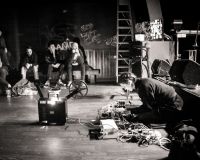Lunchtime talk write-up
Posted on Mon 12 Jan 2015
A few things I learnt from the Shadowing Lunchtime Talk
On 26 September, our Studio Producer Verity McIntosh and Creative Technologist David Haylock gave a brilliant Lunchtime Talk about this year’s Playable City commission, Shadowing. Here are a few key points I took away:That depictions of future ‘Smart Cities’ may have left something out……
The Shadowing team testing one of the lights on Leonard Lane
Posted by

Jasmine Butt
Jasmine is a musician, synth builder and AV artist who is currently exploring modular synthesis.On 26 September, our Studio Producer Verity McIntosh and Creative Technologist David Haylock gave a brilliant Lunchtime Talk about this year’s Playable City commission, Shadowing. Here are a few key points I took away:
That depictions of future ‘Smart Cities’ may have left something out… Verity began the talk by giving examples of some of the ultra-efficient design futures we are often exposed to in today’s advertising. In these cities, you won’t get lost, talk to strangers, or be surprised, because you will be constantly reminded of where you are, where you’re going, who you are meeting and what you are doing next. Verity explained that the Playable City concept was partly born out of the realisation that there is something missing from these depictions of high-tech, frictionless futures. They don’t give space for happy accidents or for people to have their own feelings about a city, or to truly engage with the architecture, people or attitude of a place.
How the Playable City concept took shape… In 2012, the British Council and Watershed held a five-day sprint in the Studio with artists and designers from across East Asia and the UK exploring the theme of The Playable City (a term coined by Watershed Producer Victoria Tillotson). Since then Watershed has orchestrated a Playable City exchange programme between Bristol and Recife, Brazil, and two years of the Playable City Award, which annually commissions a citywide project to be developed and launched in Bristol.
The promises and pitfalls of using what the streets already have to offer… The first two commissioned Playable City Award projects, Hello Lamp Post and Shadowing have something in common in that they use the city’s existing infrastructure and technology in order to seamlessly place a playful intervention into the city. Hello Lamp Post combines the codes found on street furniture with SMS to create conversations between a city and its inhabitants. Shadowing adapts the city’s existing streetlights so that they record, temporarily store and project shadows of previous passers by beside you as you walk underneath them. Shadowing had some practical challenges when it came to installation; As if squashing projectors, computers, cameras and a lot of other tech into lamp-post heads wasn’t enough, they had to be installed out in the elements, 20 feet off the ground. David pointed out – ‘it’s not at all like installing art in a white cube gallery’…
That people often find it easier to play when given the chance to become someone/something else… How often do you see people leapfrogging, dancing the tango or staging a duel in the street? These are the kinds of things that pedestrians got up to when given the chance to become a shadow that would appear in a stranger’s path.
The Playable City team are planning to take Shadowing to different cities around the globe this year and the 2015 Playable City Award will be open to new ideas in just a few weeks. Follow @playablecity to find out where it might pop up next.